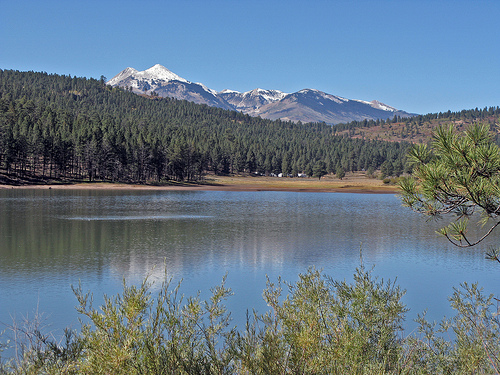The Buckeye Recreation Area on the Manti-La Sal National Forest in southwestern Colorado is a jewel in a spectacular setting. Ponderosa forests, a sparkling blue reservoir and towering peaks surround it.

Buckeye Recreation Area on the Manti-La Sal National Forest in southwestern Colorado. U.S. Forest Service photo.
Until 2010, it consisted of dilapidated facilities and barren shorelines with compacted soils. Off-highway vehicle trails crossed the entire area, and vehicles routinely traveled across the dam. Read more »
Miscanthus giganteus was a tall, bothersome grass a few years back, a good privacy plant, but to some, just a weed. It could grow about anywhere, reaching heights of 12-15 feet, and do it perennially for 20 years or more.
Some say Miscanthus giganteus had a bad reputation, but it doesn’t bother Terry Lowe anymore. He’s hoping to turn it into renewable energy while it grows on 31 acres of his 66-acre farm in Ashtabula County, Ohio. Read more »

Major General Eddy Spurgin conducts key leader engagements with Iraqi military senior leaders in southern Iraq.
When on duty, Major General Eddy M. Spurgin is the commanding general for the 36th Infantry Division of the Texas Army National Guard, but when stateside, he serves as the district conservationist for USDA’s Natural Resources Conservation Service (NRCS) in Big Spring, Texas. Read more »
As the head of USDA’s public health agency, I am responsible for ensuring that the nation’s commercial supply of meat, poultry, and egg products is safe for American families. I approach this role not only as a food safety expert and a physician, but also as a mother. And I want to address the national conversation over the last few weeks about the safety of Lean Finely Textured Beef (LFTB).
I believe it is important to distinguish people’s concerns about how their food is made from their concerns about food safety. The process used to produce LFTB is safe and has been used for a very long time. And adding LFTB to ground beef does not make that ground beef any less safe to consume. Read more »
This is the third installment of the Organic 101 series that explores different aspects of the USDA organic regulations.

Organic certification requires that farmers and handlers document their processes and get inspected every year. Organic on-site inspections account for every component of the operation, including, but not limited to, seed sources, soil conditions, crop health, weed and pest management, water systems, inputs, contamination and commingling risks and prevention, and record-keeping. Tracing organic products from start to finish is part of the USDA organic promise.
Amidst nutrition facts, ingredients lists, and dietary claims on food packages, “organic” might appear as one more piece of information to decipher when shopping for foods. So understanding what “organic” really means can help shoppers make informed choices during their next visit to the store or farmers’ market. Read more »

David Fink, owner of Heidel Hollow Farm, described the farm’s energy savings from the 896 panel solar array funded by USDA Rural Development to USDA officials and others gathered at his farm.
The sun shone brightly on the 896 panel solar array at Heidel Hollow Farm in Germansville, Penn., as USDA Rural Development Deputy Under Secretary Cheryl L. Cook, other USDA officials and guests celebrated the farm’s successful renewable energy project and the announcement of a new USDA Renewable Energy and Energy Efficiency Report. Heidel Hollow Farm, a family-owned, 1,600 acre hay farm, was awarded two USDA Rural Energy for America Program (REAP) grants in 2010. The grants were used toward a solar energy project that provides approximately 252,800 KW of electricity used in the hay compressing operation of the farm and an energy efficiency project that replaced one diesel engine with five electric motors, saving over 8,000 gallons of diesel fuel each year. The compactor increases the density of baled hay by 2 1/2 times for more efficient shipping to overseas customers. Read more »




